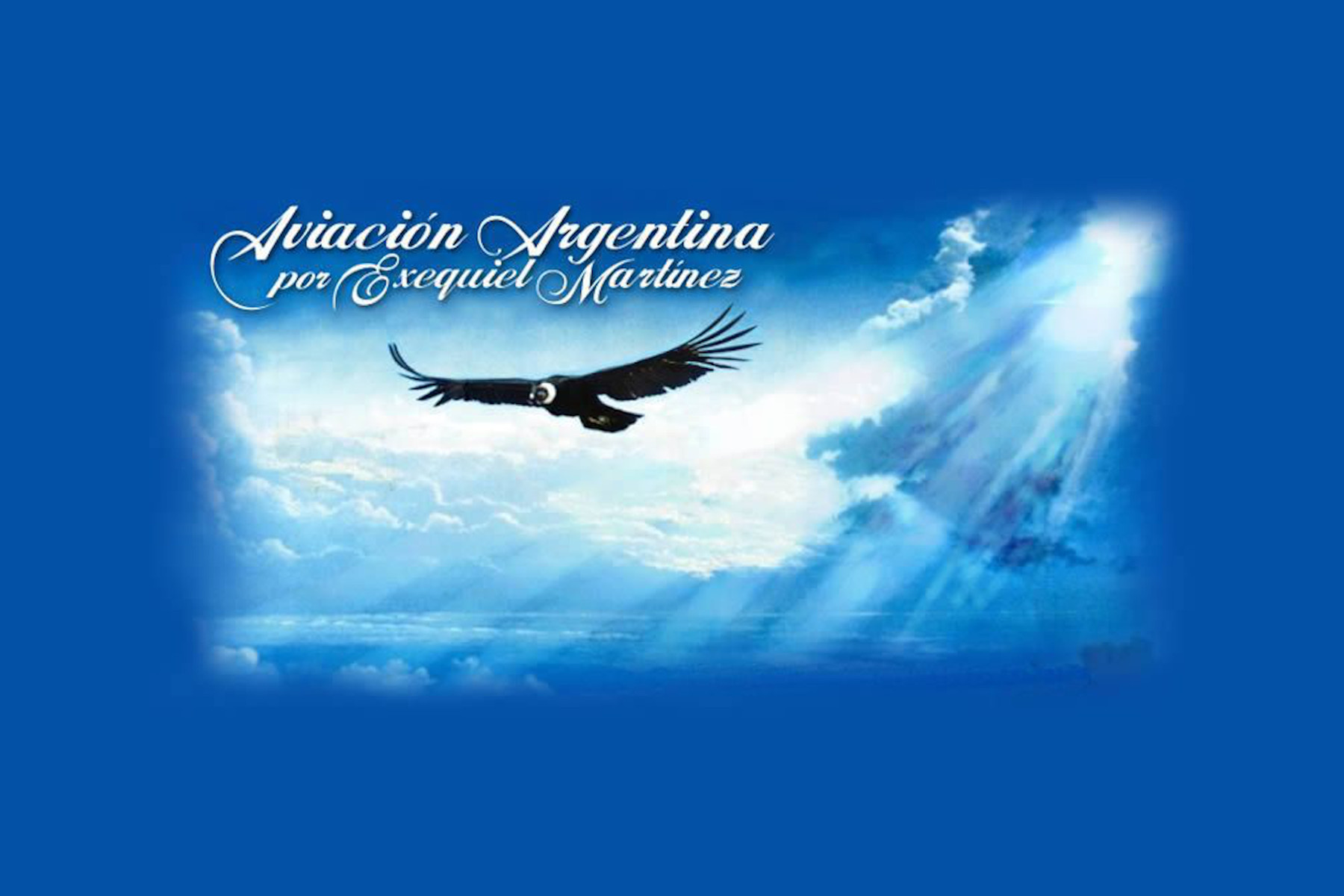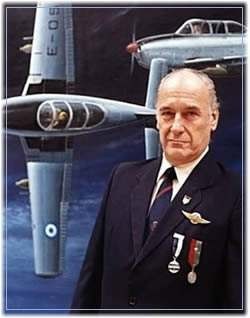
Exequiel Martinez
Certifications
- Militar Pilot 1963
- TLA Aeroplanes 2386
- TLA Helicopters 001
- Instructor – Helicopters 101
- Aerophotographer 745
Biography
1939
Born in Monteros, Province of Tucumán, Argentina.
Complete name: Exequiel Fernando Martínez Auguste
1947
Her family is translate to Deán Funes, Córdoba, Argentina
Primary and Secondary school
1958
Admitted to the “Escuela de Aviación Militar” (Military Aviation School).
1963
Receives his Wings as Officer of the Air Force.
1965
Accident flying a Mentor in Mar del Plata (Buenos Aires, Argentina).
1969-1971
Commended by the Commander of Operations of the AAF (Argentine Air Force) for his role in the rescue of Base Matienzo.
Flew helicopters to rescue people during a flood in Buenos Aires.
Member of the Air Lift Rescue team of Matienzo Base in Antarctica, flying helicopters during 34 hours without stopping. This base had not received supplies from the Navy for two years due to adverse weather conditions, thus the situation was critical as it was isolated and food and fuel were running low .
Member of the Squad that wins the AAF’s Shooting Cup for propeller driven planes.
Operates with choppers in the mountains with the Comission of Delimitation of Borders with Chile.
Dexterity with gun competition at VII Brigada Aerea: First place and first prize.
Bronze statue of the Federal Police for his help in combined operations with helicopters to fight crime.
Contratulated by the Commander of Operations for his design of a gunsight for gunned helicopters.
Takes part in two Antarctic Campaigns.
1972
Leaves the AAF.
Hired by “Utility Helicópteros”, he works in the copper mines in Andalgalá, Catamarca, Argentina.
Hired by Girodyne SA, he flies helicopters in the mountains in San Martín de los Andes and Ushuaia (Patagonia).
1973
With Girodyne SA y C. Nobleza he rescues beachgoers from the sea in Mar del Plata: 67 saved, 5 sent to hospital and nobody drowned during the summer season.
Invited to lunch with Mirtha Legrand (a very famous Argentine actress who has a TV show were guests are invited to have lunch) .
Best ad of the year is won by the campaign, as it encouraged saving lives.
He performs the first night flight by instruments for an helicopter through an “aeroway”, which was a sanitary flight that took the following route: Aeroparque-Rosario-Cordoba .
Enter the company RACA-Hughes as a test pilot.
As test pilot he flies the first civilian Argentine helicopter that performs air acrobacy (rolls, aileron rolls) at San Fernando, as a German Bo-105 had recently accomplished in Le Bourget.
Operation La Rioja: placed a TV station in a mountain and flew the authorities to this unaccesible place.
Mirtha Legrand
During this season, there was a competition taking place on TV between two shows with similar characteristics but broadcasted by two different stations. Mirtha Legrand and Analia Gade competed in a challenge and a jury scored the shows.
One show started off with music, studio scenary and the anchorage of Analia Gade. At the same time, the other station had a view of the seaside taken from a balcony of the Hermitage Hotel with music as backgroung. The camera then focused on a little dot in the sky that started to grow and then a helicopter got closer until it went to stationary above a stage on the street. When the cammera zooms in the cockpit, Mirtha can be seen waving at the people that was waiting for her close to the hotel. The chopper then lands in the street and Mirtha gets down to start her show. Mirtha Legrand won by an important margin, the biggest different being the beginning of the shows. This was a series of promotions between both companies.
The pilot was invited to the classical lunch, but he declined as he had no replacement in case an emergency happened.
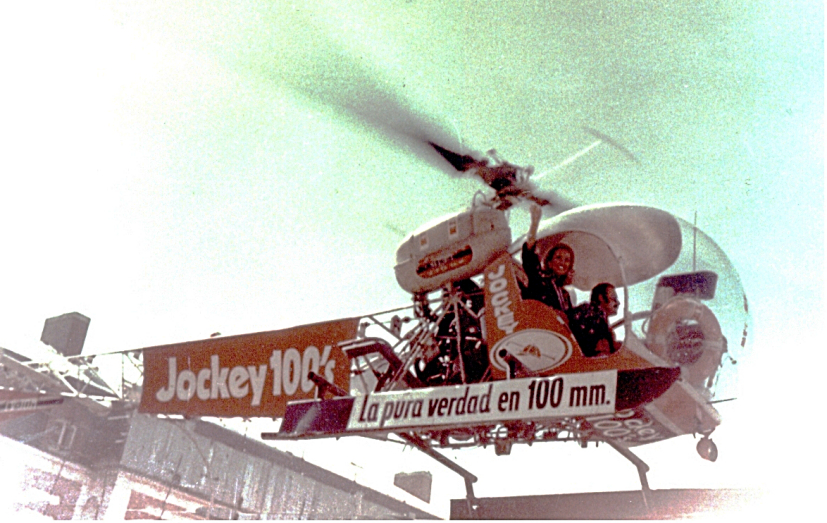
He rescued the surviving mountaineers and while he was working to remove the remains of two dead ones from a crack in the ice, he received an SOS on the radio. He was informed by the campment that there was a truck trapped in the river and the rising waters were going to cover it, while there were still two people that had not been able to leave it. The problem was not wether they were able to swim or not, but that the temperature of the water was close to 0 degrees Centigrades, and that they would not be able to withstand more than 3 minutes in it, as their hearts would stop. He dove like an owl towards the area as time was running out and he smoothly placed his helicopter close to the truck, on top of which the driver and his auxiliary had climbled. The toughest thing about rescues in a fast flowing river is that due to the high speed of the water the pilot may get confused and dizzy. The sight must be placed on a fixed point outside the river and then taking into account the height of the truck and the people, maneouver with periferic sight. Sometimes this position does not coincide when the wind is blowing from straight ahead, as it was in this case, and then the rescue must be done with the wind blowing from the tail regardless of the complexity of this maneouver, because it is worst to get dizzy and provoke an accident.
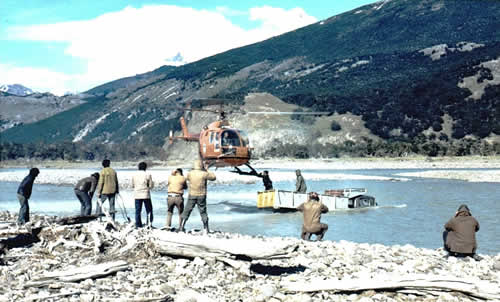
1974
He flies helicopters during the Great Flooding in the Argentine Northeast. Rescues, evacuations, shipping of food and medicine to Santiago del Estero, Salta and Jujuy.
He continues Operation Barro (Mud) in the West of the Chaco, in the area around Santa Silvina.
An illustrated report he wrote is sent to the President of Argentina and then he is congratulated by the national authorities.Helicopters under his command carry out trips between hospitals, technicians, specialists, authorities, sports events (air ambulance during Formula 1 races), etc.
He is named personal helicopter pilot of the Argentine President.
Operation Calor (Heat): Commanded by the President, he helps remote places of the Patagonia and Tierra del Fuego during strong snow storms.
He is appointed test pilot for the Hughes 500 helicopters, assembled in Argentina by RACA-Hughes 500 in their factory at San Fernando, Buenos Aires.
He is given the Martin Fierro Prize due to his work as a helicopter pilot and his actions on behalf of the community.
Commended for his paintings that portrayed the Argentine Aviation.
Receives the Gallo de Bronce (Bronze Rooster) from the Policía Federal (Federal Police).
He is named Flight Instructor teaching the future Instructors of the Police of Buenos Aires Province, flying a BO-105B.
This was a very exciting year with several appearances of the helicopter in the media. Rescues at Mar del Plata had been recorded, the operation at Fitz Roy had international repercusion. One of the fallen was the son of a US Senator. He had saved 79 lives in Mar del Plata. He had taken food to isolated snowed places in the Patagonia, helped and saved people during floodings in Jujuy, Salta, Santiago del Estero, Chaco and Santa Fe. A grand total of 2,500 people. He also carried out the first nocturnal flight of an helicopter taking a patient from AER to CBA. All these facts must have moved the jury to this speciality in the classical prize of 1974. In the picture, the host of TV Station 11 gives him the statute that at that time was made in wood. His satisfaction was due to the fact that this important task of saving people in the community was being recognized, though life guards, mechanics that descended into the crack in the ice and several others of the team should have been with him at that moment.
“For your actions towards the wellbeing of the community and the scores of lives you have saved” were the words spoken when he received the prize.
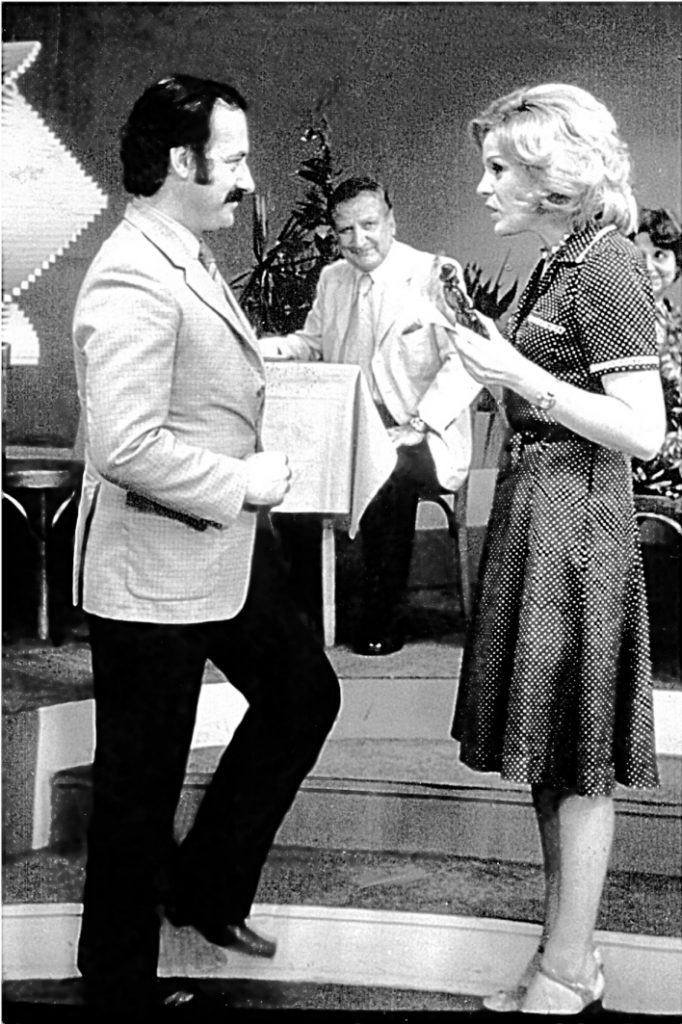
It was hard to believe when they called me from TV station 11, and even more when besides receiving my prize, I was the one in charge of presenting his Martin Fierro to no other than my admired composer Marianito Mores.
This took place on November 4th, 1974.
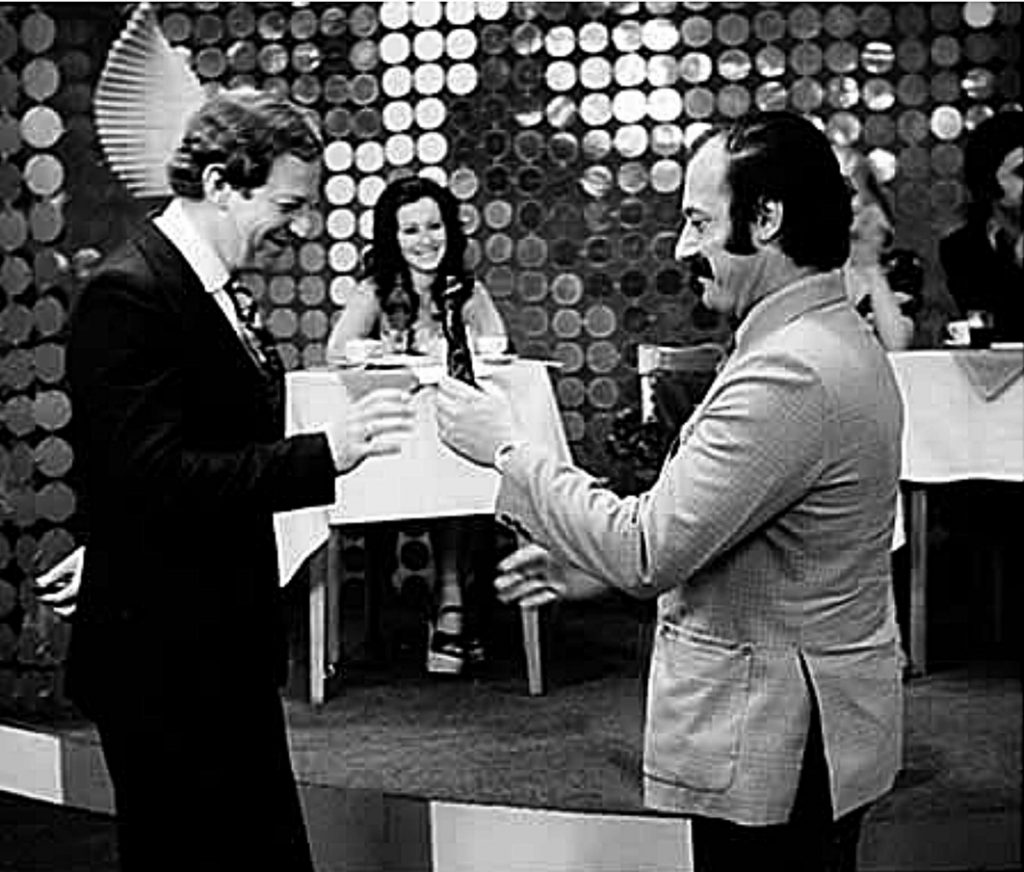
1975
He continues with the operations for the National Health Ministry and the test flights of the H-500s.
Sent by RACA SA to Lima (Perú) where he gives a conference to the Peruvian Air Force pilots about the use of the helicopters they had recently received.
1976
Carries out Operation Sauzalito-Chaco. Flies authorites to Misión Nueva Pompeya and from that place he performs an air bridge during the night to help the native people isolated by the flooding provoked by the river Teuco at El Sauzalito, taking food and water to them (February).
He transfers a helicopter purchased by the Chaco province. He gives a conference about the usage of aircraft in the development of zones, and different usages for the authorities of the Province.
He is offered the position of pilot of helicopters of the Chaco Province and he accepts it to start the challenge of converting 4 milion hectares of virgin forest into a productive zone, enlarging the agricultural boundaries of the country.
Working for the Institute of Colonization, he suggests the usage of towers made of alluminum to reduce the time it takes to measure the fields. In 2.5 years 2,500 km of roads are made, when it would have normally taken 5 to 7 years.
He is congratulated by the Government of the Chaco for his help to reduce the costs and time of the Campaña del Oeste, thanks to the usage of the towers that were transported by helicopters and the countless applications of the aircraft as efficient tools in the development of distant areas.
Works to eliminate the “rancho schools” (poor schools in the countryside).
Using his helicopter, he rescues a Piper of the Aeroclub Resistencia, that had fell in a swamp area. The tape shot in that opportunity was sent to the Hughes factory in the US.
He is an ad-honorem air photographer for the Defense Plan against floodings.
Rescue of Crashed Aeroplane
The engine of the Piper suddenly stopped while flying in the Paranacito area.
The only place available to land was a field in the center of an island surrounded by water. There was no way to get him from there and there were talks underway to make a road and a couple of bridges to rescue him when the use of the helicopter was suggested by me.
To prevent the plane from flying in a different direction to the one of the helicopter, its wings were dettached and tied to the sides of the fuselage. The cables were placed in a way that the plane had a negative angle and thus would not have lift, keeping the cable straight. The rudder would keep it straight without turning.
As we were at the limit of the weight that we could lift, all the things that were not necessary were removed: belts, fabric from the seat, doors, leaving only the seat of the pilot who was flying in short trousers and without shoes. The fuel was only enough to fly from the island to the aeroclub.
It was the first time that I had a problem like this to solve. I calculated the length of the rope, the weight of the plane and the ground effect (cushion of air that forms below the blades of the helicopter while flying stationary). If the rope was too short, the ground effect was better but the innertia was worst and the load could swing dangerously. I choose a length that was one and a half of the diamater of the propeller.
— I am going to try a stationary flight in order to check if I had enough power and then I will take off with a gentle turn to the right. At that moment I will be able to see you. If something goes wrong, arms down! – I told them.
I aimed towards the South in stationary flight for the wind to help me. The load was now hanging and the needle was biting the yellow zone. The available power was the small yellow zone before the red.
I waited for a wind gust to help me during the most critical moment, which is when you go from stationary to transitory flight.
I felt the gust in the commands and started to move putting the needle in the top part of the yellow arc, while counting the seconds: – one thousand…two thousand…three thousand… The wheels of the Piper sunk in the mud a little bit and…we were flying!!! I swiftly reduced the power and focused on the high and dense forest at the end of the clear. As I was barely able to climb, I could not attain speed and height with such a slow remaining power, so I dived a little bit, and the gained speed helped to increase the climb and I was able to pass the trees. I did a very gentle turn looking for the assistants with my eyes. All of them had their arms down! Almost without breathing I completed the 180 º turn and landed with the load in front of the chopper.
You were dragging a 5 meter long rope below the plane that passed among the trees and it was a miracle that it did not got hooked in anything!! – And who the h… left that rope untied!!! – I answered.
We checked everything and I took off again with the needle in the yellow zone, the little dive and combing the trees. Gentle turn and all the arms are up this time.
I left the Piper in front of the Aeroclub.
A journalist filmed the operation and the movie was purchased by RACA-Hughes in San Fernando, who in turn sent it to the US because it was the first rescue of a plane carried out by a H-500.
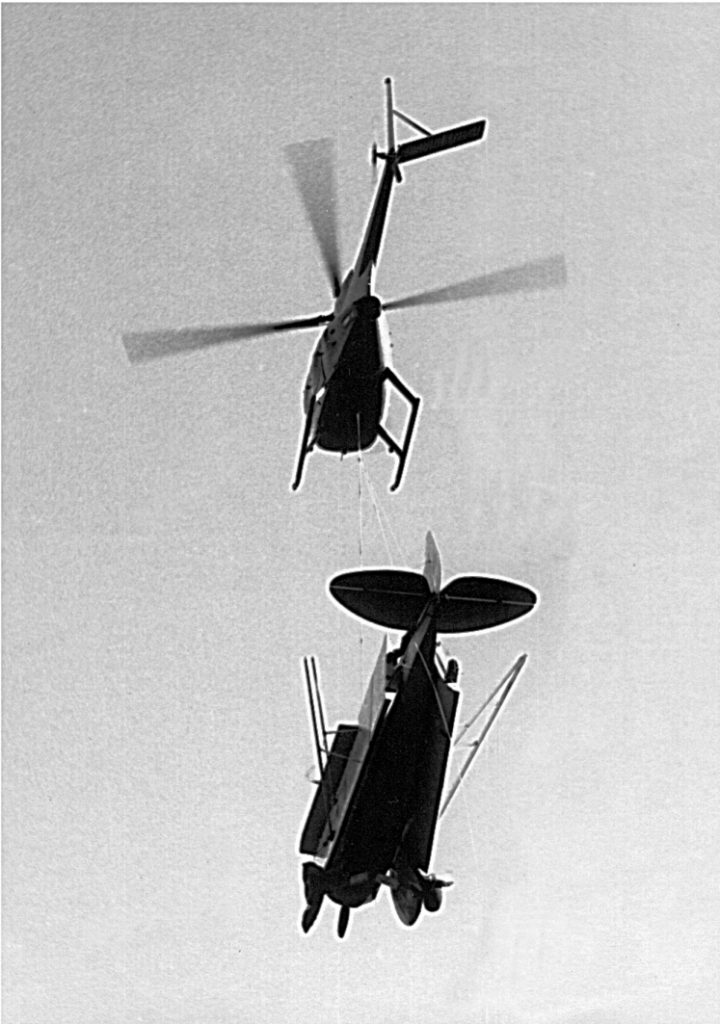
1978
Due to the conflict with Chile he takes part in a Squadron of volunteer pilots that later on was known as Fenix Squadron.
He is called to the VII Air Brigade, Argentine Air Force.
When the conflict is over he returns to his SAR missions and rescues the crew and passengers of a hidroplane that fell in the Ibera Lake.
1979
Evacuation of the population of flooded Villa Bermejito. With stationary flight he dries a racing track, thus allowing a national sports event to take place.
During a storm, he helps to mark a 30 mt long pontoon bridge of 300 m/tons that was loose and endangered the navigation of the Parana river and the bridge Chaco-Corrientes. He volunteered for this mission because other pilots did not want to fly it as it was considered dangerous and outside safety margins.
1980
Operation in Bajos Submeridionales.
Support operation to the Channel Colony Frías-Fuerte Esperanza.
Rescued three people lost in the marshes of the Guaycurú River.
1981
Operations in the area affected by the floodings in the West of Chaco.
Donates the Ministry of Education a research work about the animals and plants of the Chaco.
Promoted to Capitán (RES) AFF.
1982
Takes part in the South Atlantic conflict, flying Bell 212 for the Air Force from San Julian. His war name was Chaco during the SAR missions that were flown to assist the squadrons going to and returning from the Malvinas Islands. Also identification of ships, transport of bomb fuses, patrols, search of British Commandos and other missions were carried out.
Several pilots, after their debriefings, told about the missions to “the painter of our things”. These stories, along with the ones of Capt. Pablo M. R. Carballo were the basis of the AFF’s Baptism of Fire told in images.
After the conflict, he illustrated the books “Dios y los Halcones”, “Halcones Sobre Malvinas”, “La Batalla Aérea de Nuestras Islas Malvinas”, brochures, posters and other publications.
The International Organization of Civil Aviation celebrated it’s 50 years with a painting of his that was declared Patrimony of the City by the Major of Montreal. There are paintings by Exequiel in the USA, Russia, Venezuela, Ecuador, Perú, Bolivia, Brasil, Paraguay, Uruguay and Europe.
1983
Rescues the victims of an air accident near Empedrado (Corrientes).
lHis paintings are used in the books “Dios y los Halcones” and “Halcones sobre Malvinas”, the royalties of the author and the illustrator are given to the families of the members of the AAF that died during the war.
Works as air photographer ad honorem in the Plan of Defense against Floodings of the Gran Resistencia”.
1984
His work and collaboration to the Plan of Defense earns hims the congratulations of the authorities.
Takes part as an active member of the 3rd National Congress of Conservation and Sport Fishing, in Resistencia.
1985-87
Keeps on working as helicopter pilot, air photographer, technician of the Plan of Defense and painter of aviation subjects..
1988
By request of ALFA S.E.M. he becomes the Chief of Operations for six months, organizing it and flying the first flight of this company that promotes the development of the interior of Chaco. After those months, he returns to his everyday activity.
1989
Using an helicopter, he transports personnel and materials to fix Tower #349 of the system NEA, after it had been destroyed by a twister that left 4 provinces of the NorEast without power. As it was located in a marsh, it was impossible to get there by any other means of transportation. The speed and efficiency of this operation earns him the compliments of the press and the congratulations of the Government.
He is named sterward of the union, managing to get the fullfilment of the regulations and demands for the aeronautic personnel.
1991
He receives the veteran of war diploma and medal issued by the National Congress.
An emergency landing is carried out due to the loss of the counterweights of the wings of the Bell 212 in Saenz Peña- Chaco. The technician of Bell that investigated the case said that during this kind of failure the loss of the rotary wings happens in a few seconds and that they saved their lives thanks to the quick reaction of the pilot, who did not waste time executing the procedure of this kind of problem and landed the helicopter in the shortest time. The cause of the loss was rust inside the rotary wing.
Contratulated by the Government of Chaco for his action during the above mentioned emergency, saving the lives of the passengers and the helicopter.
His labor in the Chaco Province, showing the importance of the helicopter as a tool for the development of the isolated areas of the interior, motivates him to ask the repair of the twin engined Bell 212 .
The alternative of buying a cheaper single engined helicopter is rejected by him because the Chaco is one of the worst places of the world for a pilot flying this kind of helicopters. This place is called the El Impenetrable and it is 5 million hectares of virgin bushes with very hard wood. With an average of 4 meters of distance among the trees and very small leaves, the branchs look like forks pointing to the sky. There is no room for an emergency landing in case of failure of the engine. Because of this, it is indispensable to use multiengined helicopters. A problem with the motor in a single engined craft in Buenos Aires or La Pampa is an emergency, in El Impenetrable is without doubts fatal or of grave consequences. Martinez had 3 failures in a Bell 212 and returned with the other engine. Had he had a single engined chopper, he would have died 3 times.
1992
He is distinguished by the Instituto Jorge Newbery with the “Orden al Mérito Newberiano” (Order to the Newberian Merit), with the Grade of “Caballero” (Knight) for his “notable and patriotic work towards the knowledge and divulgation of the history of the Argentine Aviation”.
He is appointed member of the Instituto de Historia Aeronáutica Argentina (Argentine Aviation History Institute), thus becoming the first painter-historian.
1995
Picture Revista Aeroespacio
To celebrate the 50th anniversary of the creation of the OACI her president, Dr. Assad Kataite received from Brig. Héctor Cid delivered a painting made by the Argentine painter Exequiel Martínez.
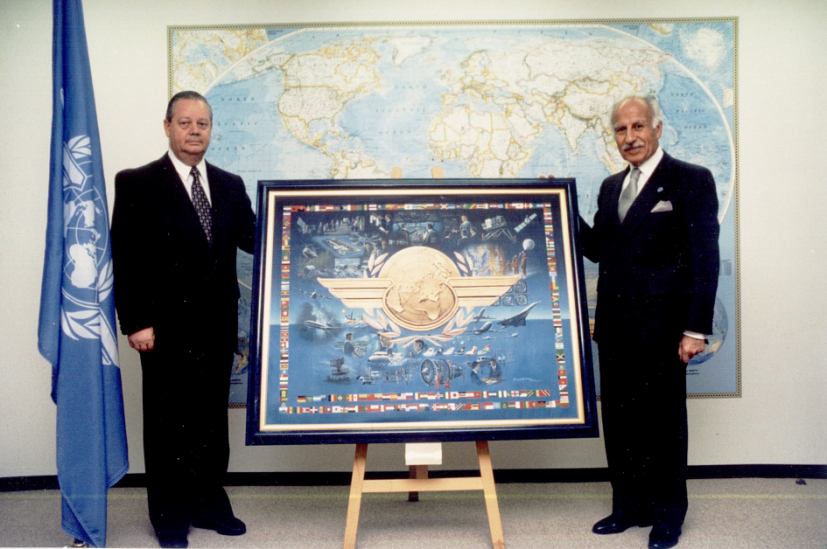
Incorporated to the heritage of the City by the Major of Montreal.
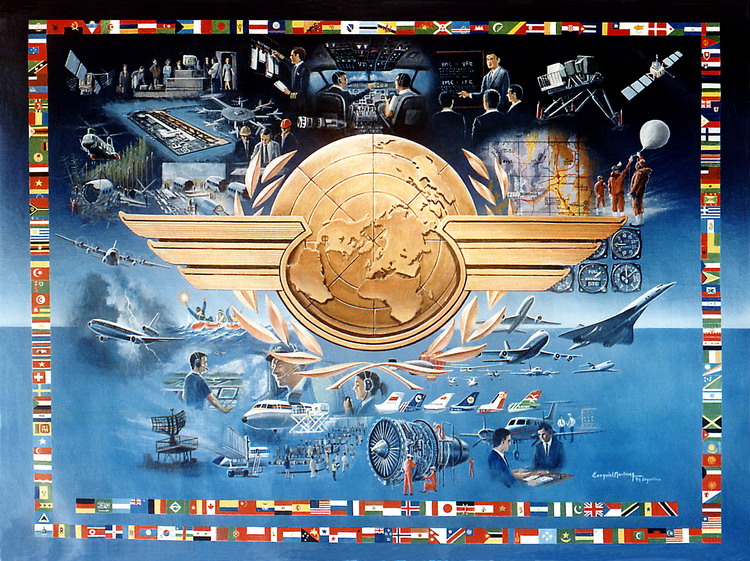
1996
Not being repaired the helicopter for more than five years calls for voluntary retirement to dedicate himself to painting.
2000
Press and several organisms where asking the Government to fix the damaged rotor blade so the helicopter could continue to serve the community was in need of. Notwithstanding the Government would not bulge. The pilot was afraid they were going to purchase something not suitable for the task because if that is the case it would not be used for what it was destined to do.
This is one of the several articles published in the media thru which the citizens were asking for the Bell 212.
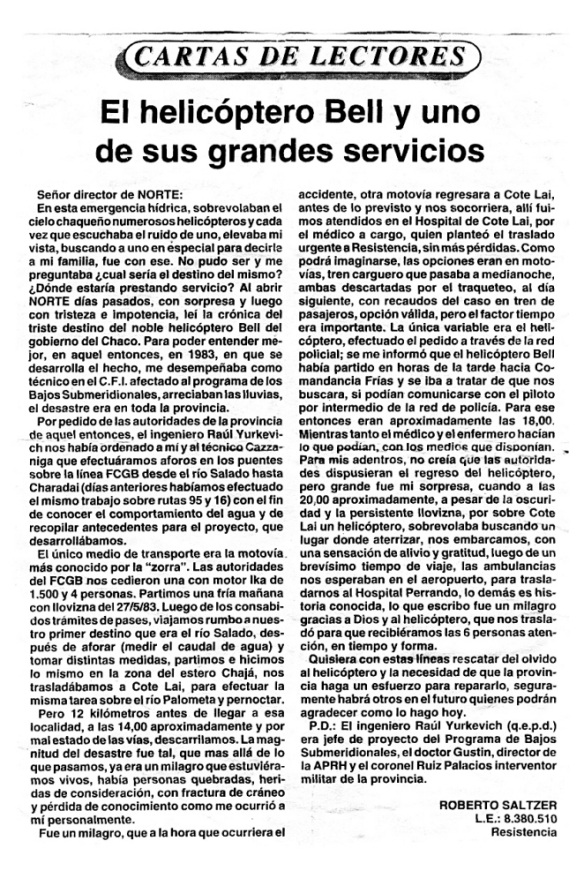
2001
Government of Chaco Province sold without informing her pilot the Bell 212 that only had 2,000 flying hours whereas the ones serving in the Air Force and Oil companies that had between 15,000 and 50,000. This new single-engined helo had design problems that meant that over 100 knots and while pressing the left pedal the tail rotor touched the tail cone. There were accidents and there was a report that limited the flying speed to no more than 100 knots. Then there was another bulletin that mandated the replacement of the tail section. Nevertheless the helo could not be flown faster than 100 knots!
As the engine is supercharged an onboard computer controls the performance not to damage the engine. When the pilots increases the power in order to leave a confined area or fight a downdraft the computer triggers a limit not to damage the engine and thus the helicopter cannot escape from the situation.
The Province of Salta had two of these helicopters. One fell in an accident and the other one had an infamous fall in the Andes with the President of the country as a passenger. Martinez, the pilot of Chaco, was not asked and was not able to give his advice regarding the purchase of this helicopter that is not fit to serve in the geography and environment of the Province of Chaco as it is a single-engined machine and had a history of problems. Martinez offered to travel to the USA to further learn the operation. The answer was his dismissal and forced retirement. Now he could live as a painter.
Main page of his memories called “Farewell to two war and peace veterans” taken in front of the truck on which the Bell 212 “Chaco” was being loaded to be taken to Buenos Aires.
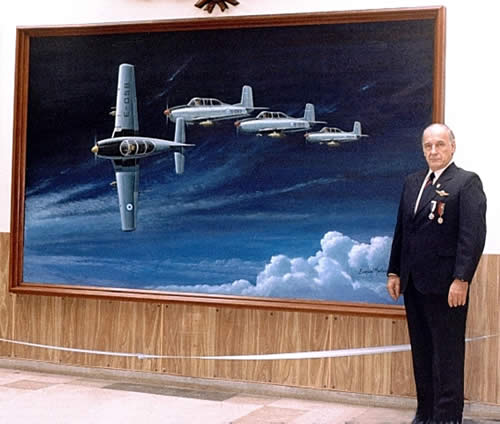
When the Chieff of the VII Brigada Aérea told me that the painting was very deteriorated, I asked him to send it to me to restore it. Due to it’s size (4×2 mts. approx.), it was taken by a C-130 that was transporting personnel and materials to the units in the area. The Underofficers Mess donated the material and presented it during a show. …It was a very touching moment for me, meeting again with my first painting after 35 years. Years had gone by for both of us, I was no longer the First Liutentant who got angry with the clouds that were not correctly painted and discovered that making them with the hands was better than with the brush….I was using airbrushes, acrylics and was better known, but with a lovingly care I restored with my hands full of wrinkles this, my first beloved painting of planes.
